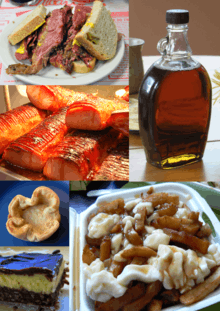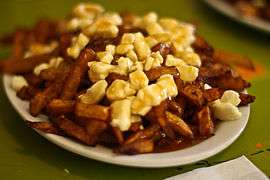Cuisine of Quebec
 |
| Part of a series on |
| Canadian cuisine |
|---|
|
Regional cuisines |
|
Religious and ethnic |
|


Quebec's traditional cuisine is as rich and diverse as the province of Quebec itself. The historical context of 'traditional' Quebec cuisine is from the fur trade period, and many dishes have a high fat content through the use of ingredients such as lard.
Traditional cuisine
Quebec is most famous for its poutine, tourtières (meat pies), pâté chinois, pea soup, baked beans, cretons, ham dishes, maple desserts such as Grand-Pères and molasses treats such as "tire Ste-Catherine" (St. Catherine's taffy). The strongest influences on traditional Quebec cuisine come from the cuisines of France and Ireland, as the two largest ethnic groups in the province are French and Irish, although many aspects of Canadian aboriginal cuisine have also had a significant impact on Quebec cuisine.
The sugar season (temps des sucres) is one of the oldest of Quebec culinary traditions. During springtime, many Québécois go to sugar shacks (cabanes à sucre) for a traditional meal that features eggs, baked beans, ham, oreilles de crisse, and bacon, which they then cover in maple syrup. Associated activities are a horse-drawn sleigh ride in the woods and sugar on snow (tire sur la neige) — boiled maple tree sap dribbled over snow, which then hardens, and is eaten as a treat.
Many traditional dishes are intrinsic to holidays. Réveillon, the Christmas Eve (or New Year's Eve) feast, usually features items like a bûche de Noël (Yule log) and tourtière.
Spruce beer is a traditional beverage.
Poutine is widely considered to be Quebec’s signature food. The messy pile of fries, gravy, and cheese curds isn’t new, but in recent years it’s experienced a renaissance, spreading across Canada and beyond. Gourmet versions have appeared in trendy gastro-diners and even the New York Times has jumped on board, celebrating poutine’s arrival in Manhattan.
The Montreal-style bagel is wood-fired, and many of the city’s bagel joints do their baking within view of the seating area.
Tire sur la neige, or sometimes simply tire d’érable, is a taffy formed by pouring still hot, boiled maple sap directly onto fresh snow. The result is a soft, flexible candy that begs to be eaten immediately. Tire sur la neige is available at most sugar shacks. These visitor-friendly maple syrup production outfits are found across southern Quebec, with the highest concentration in the Montérégie region (on the south shore of the St. Lawrence, near Montreal) and the Laurentians.
Quebec’s cheese scene is so vibrant that there is an entire route des fromages designed for cheese tourists. Part of the reason for the province’s thriving dairies is its legalization of young, raw-milk cheeses—the production of soft cheeses that have been aged less than 60 days is banned in much of North America.
Drawing its roots from French cuisine, Québec’s cuisine was largely shaped by the difficult early years after it was settled. Today, many traditional dishes take pride of place at Christmas and New Year’s celebrations.
See also
References
- Mongrain-Dontigny, Micheline (2003) A Taste of Maple : History and Recipes, Saint-Irénée: Éditions La Bonne recette, 127 pages ISBN 978-2-9804058-9-1
- Couillard, Suzette and Normand, Roseline (2002) Best Quebec Recipes of Bygone Days , L'Islet: Éditions Suzette Couillard, 367 pages ISBN 978-2-920368-06-4
- Armstrong, Julian (2001) A Taste of Quebec. Second Edition, Toronto: Macmillan, 214 pages ISBN 978-1-55335-005-7
- Mongrain-Dontigny, Micheline (1995) Traditional Quebec Cooking : A Treasure of Heirloom Recipes, La Tuque : Éditions La Bonne recette, 156 pages ISBN 978-2-9804058-2-2